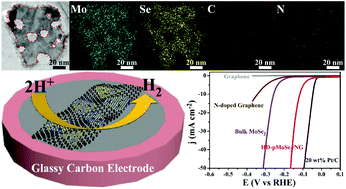Polymer-confined growth of perforated MoSe2 single-crystals on N-doped graphene toward enhanced hydrogen evolution†
Abstract
The edge and corner atoms of 2D transition metal dichalcogenides (TMDCs) are the main electrocatalytically active sites for electrochemical reaction. Here, we demonstrate an approach to generate abundant edge/corner atoms in molybdenum diselenide (MoSe2) nanocrystals supported by nitrogen-doped graphene (NG) which consequently leads to significantly enhanced hydrogen evolution reaction (HER) activity. These structures were fabricated by firstly absorbing the Mo-containing precursor within polymer-functionalized graphene oxide, then selenized to obtain MoSe2 nanocrystals on the surface, and finally H2 etching was performed to form perforated structures. The use of a functional polymer as an absorption matrix efficiently mitigates aggregation which allows us to obtain MoSe2 single-crystals of ∼150 nm in lateral dimension, while maintaining high MoSe2 loading. We observed a remarkably enhanced electrocatalytic activity resulting from a significantly increased abundance of edge/corner atoms in hydrogen evolution measurements. Specifically, with this perforated MoSe2/NG-modified cathode, current densities of −1 and −10 mA cm−2 were realized with the overpotentials of only 30 and 106 mV, along with a small Tafel slope of 57 mV dec−1 and large exchange current density of 127.4 μA cm−2 in 0.5 M H2SO4. Such an efficient strategy also opens doors for the unparalleled design and fabrication of TMDC-based nanocomposites for electrochemical applications.



 Please wait while we load your content...
Please wait while we load your content...